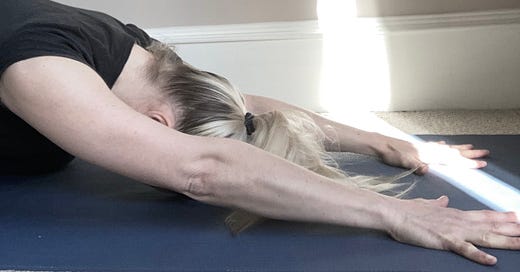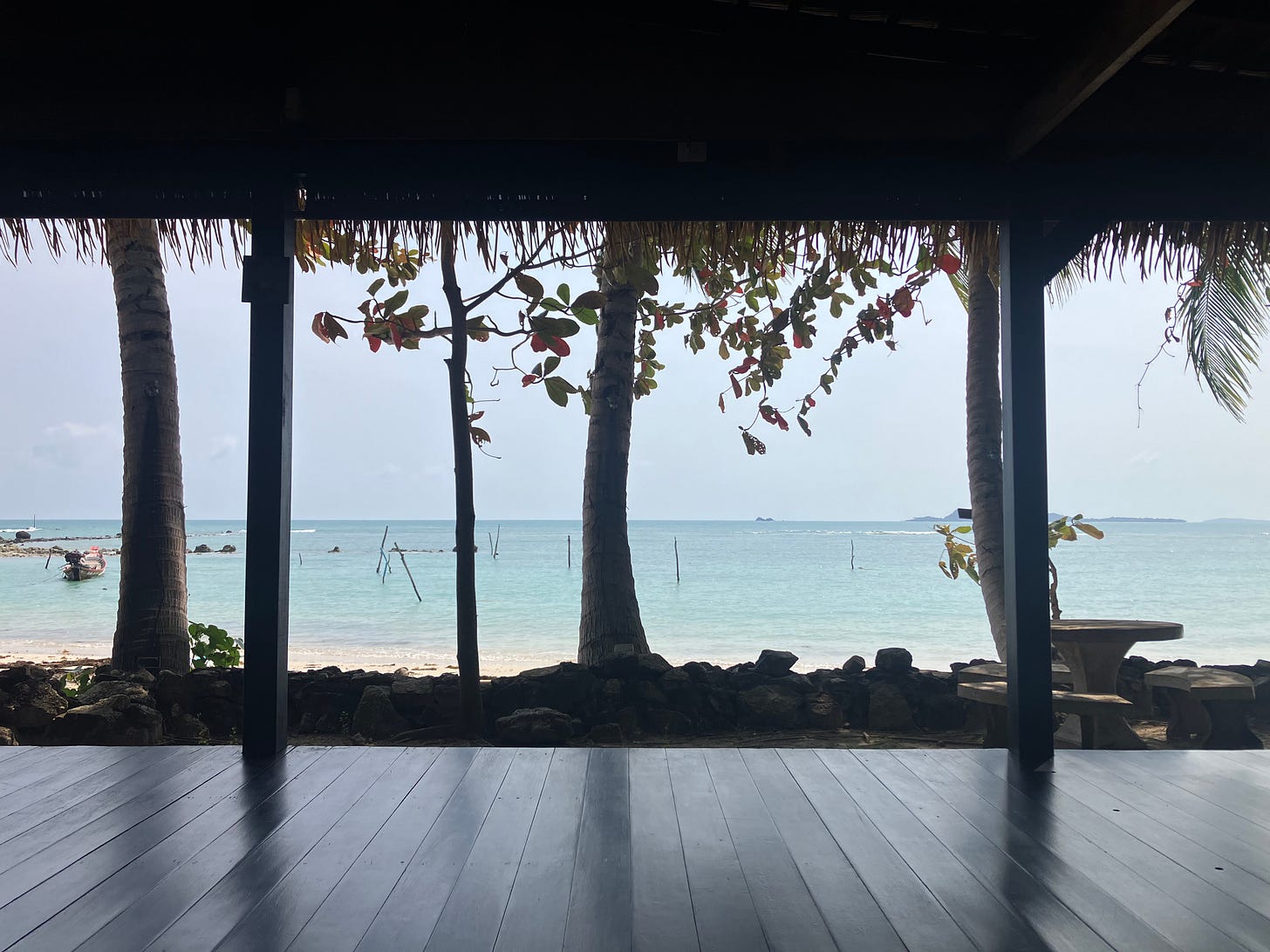A musician’s take on music during yoga .. and why I can’t go to class anymore
Hyper-sensitivity to music on the mat
As a professional musician (performer, composer & recording artist) I spend my life deeply immersed in listening to, playing, writing and emotionally responding to music. It has been this way since I was 5 years old, and will likely continue until I die. Performing in rock bands and orchestras, recording in the studio, spending long hours at home practising, writing and producing all adds up to an intense level of sound exposure, and it’s important for my health that I also find time to switch off from music entirely.
I started attending yoga classes back in 2000 and they quickly became my refuge. Wherever I was in the world I could drop in and guarantee that I would be able to rest my ears, focus on the teacher’s instruction and allow my movements to be governed by the natural rhythm of my breath. I found a true mind-body connection in the moving meditation of the asana practice, and experienced genuine relaxation and peace in Savasana (corpse pose). I would leave the studio feeling physically and emotionally refreshed, clear-minded and calm.
I guess it was from 2009 onwards that this experience started to change. In that year, Bluetooth v3.0 was introduced, making it easier to transfer audio data. Spotify (founded in 2006) also became available on the iPhone in 2009. The availability of affordable bluetooth speakers and the arrival of personal playlists meant that music was much more portable, and ‘background music’ started to appear in some yoga classes.
Some teachers would only play music as we arrived, then would turn it off while teaching. It was still quiet during ashtanga or Iyengar classes, but gradually Vinyasa Flow became the dominant class offering, with music featuring more prominently and more frequently. Teachers would turn up clutching their little speaker, and my heart would sink slightly.
I continued to pursue my own practice and and I completed my yoga teacher training in 2017. I do teach online and run in-person workshops for musicians, but for the last few years I have found it increasingly hard to attend a yoga class as a paying client. All of the studios in my area now insist that their teachers play music. Several are actually defining their class offering around music (live and recorded) and I can’t guarantee ‘no music’ unless I go to Iyengar or Mysore.
Meanwhile, outside the studio, the general noise level in life is increasing. Today, music plays in underground stations, the supermarket, the doctors surgery (‘Stairway to Heaven’ was on the radio the last time I was in the waiting room, I kid you not), the dentist, in restaurants & bars, in taxis, during massages (awful), at the beach, around the hotel pool, in the gym, during news reports (because cancer isn’t sad enough; it needs to be accompanied by close miked felt piano)..
In fact, it’s now really hard to escape it. Is this why everyone’s walking around wearing headphones? Thousands of individuals navigating through the city, immersed in their own soundscape, moving through the landscape, but not hearing it. People want audio entertainment, but as an insular experience of their own choosing. Everyone seems to be terrified of silence, of shared space and time.
So what’s ‘wrong’ with music during yoga?
Despite Spotify’s best attempts to homogenise our listening experience, music is not benign. It is not wallpaper, or a scented candle. At its zenith, music is transcendent, emotionally wild and culturally charged. At its fundament, it is organised noise. At its most extreme, it can become torture.* You may get the impression during this blog that I dislike music, but the opposite is true. I respect music’s power immensely, I just hate to hear it used thoughtlessly or inappropriately. This is where I struggle with music in the yoga environment.
Of course there is a long tradition of sound and song within the yoga practice. The chanting of Aum, the Vedic mantras and kirtan (devotional song) all bring an aspect of live music performance to the room, and there are the complimentary disciplines of sound healing and gong baths too.
I do enjoy a good ‘Aum’: the resonance of communal vibration, a brief collective sonic experience. But what’s truly special is that moment when the last ‘mmm’ fades away, leaving an energetic resonance hanging in the air, the molecules still vibrating. Just as, when an orchestra hits the last chord and the notes hang in the auditorium, there is a brief and magical hiatus. The audience is held in suspense by the absence of sound.
At 49, I’m one of the older people in the dynamic vinyasa flow class these days, and it dawned on me recently that there must be several generations of new teachers who have never experienced a yoga practice without music. With the increase of social-media-as-advertising, teachers feel obliged to create their own ‘brand’ of yoga in order to attract people to their classes, and many think that creating their own playlists is a necessary part of their identity. It’s not enough to teach yoga anymore, you need to be a DJ too. Any teacher I speak to about this assures me that they spend a lot of time and care creating their fantastic playlists. I don’t doubt them, but I do question the need for it at all.
Are we human or are we dancer?
Humans are creatures of community, we tend to unify. When we chant we tend to ‘sing’ round about the same note, the same tone centre, because harmony is more comfortable and socially acceptable than dissonance. So when a 4/4 rhythm is playing at a steady bpm, it is natural to want to move vaguely in time with that beat.
One of the central messages of yoga is to pay attention to your body’s rhythm, to move with your own breath. But if you play music with a conflicting beat (and everyone’s breath tempo is different) we are having to ignore the impulse to move in time with the music. This creates internal conflict on a subtle level. The music becomes something we need to actively ignore or block out.
Yet classes are hardly ever cued in time with the music. So what’s the point in that rhythm being there? Who is it serving? Last week in a class I became aware that we were hearing a latin-groove instrumental cover of Marvin Gaye’s politically conscious soul classic “What’s Going On?”. Latin music is absolutely, fundamentally dance music. And we’re not dancing to it. So we aren’t even respecting it. Or Marvin. What, indeed, is going on?
Words (Between the Lines of Age)
Lyrics can be a massive distraction, especially lyrics in pop-rock songs. Words hold power. A single phrase that might seem harmless to you might reduce someone else to tears as it triggers a memory of a bad break-up or traumatic personal event. As a teacher, I don’t want to invite that onto someone’s mat.
I recall one playlist featuring a chillout cover of “Avant Gardener” by Courtney Barnett. The lyrics do feature the word “breathing” - maybe a whipsmart algorithm picked up on that - but the song is about being whisked off in an ambulance suffering a panic attack. The original is a great track, but why would you want this feeling as you fold forward?
Sanskrit mantras and songs in other languages are generally less intrusive because it is easier for words we don’t fully understand to become sounds, but it is still something I have to work to ‘tune out’ in order to enjoy my asana practice, rather than something that is adding depth and purpose.
Ambient instrumental soundscape tends to work better for me because it is often drone-based, grounding, centering, with a level of tension/anticipation. And most importantly it is arrhythmic, allowing the yoga student to follow the rhythm of their own breath. There’s a huge amount of beautiful ambient music out there by artists who are exploring immersive sonic experiences (Jon Hopkins for one). Indian classical music works well in the same way: based around the drone, the subtle fluctuations of rhythm in the ragas and the sophisticated melodic inflections of the lead instrument (eg. sitar or sarod) are more fluid and improvisatory than a repetitive 4/4 beat, allowing more freeform movement, but I rarely hear any of this in the classes I attend.
Oh No not My Baby
OK so this is niche but maybe some musician colleagues will sympathise with me here: sometimes a track comes on in class and I realise “Oh I played on this”, or “shit, my ex is playing bass”, or even occasionally “Wait, this is from my record”. I recognise that this is very specific to music professionals, but nonetheless it kills my yoga buzz as my ‘work’ is invading my relaxation space.
It’s also hard to turn off the analytical part of my music brain, so when a non-musician hears ‘a bit of piano music’, I’m probably hearing an over-compressed Roland FP4F and a bad flute sample with too much reverb. And thirdly, I’m unsure how may local yoga studios are registered with PRS as they don’t seem to display their registration, so we probably ain’t even getting paid for this, folks.
Ground Control to Major Tom
Audio geek time: a poor volume setting and a bad quality speaker will really hinder communication. If the music is too loud, the teacher has to raise their voice to be heard over it, which means the student is then having to work harder to decipher the instructions. This increases the overall level of noise in the studio, and I find it really hard to concentrate once this is happening, especially if it’s a cheap speaker and it’s distorting. As a teacher, it can be easy to forget that there’s music because you’re moving around and you’re thinking about the next cue, but if you find that students are cranking their necks looking up at you from down dog, it’s likely because they can’t hear what you’re saying.
If you rely on a portable bluetooth speaker the volume will be different for different students depending on the placement of the speaker in relation to their mat, so someone near the device may struggle to hear the teacher’s instructions at all. If you are fortunate to teach in a studio with a suspended surround sound system this should be avoidable, but if in doubt? Turn it down. Just a small reduction in volume can make a big difference to the overall experience.
All of this means that the teacher needs to be fiddling with their phone occasionally while teaching. I don’t want my phone anywhere near me during yoga.
When I find the music in class too much, I feel a rising sense of anger and panic, and often end up leaving the room as my experience starts to border on the traumatic and the yoga isn’t happening any more. Yes, I know. I’m hyper-sensitive. I guess I’m writing this because I need to know if I’m alone in this or not. And if I have left your class at any time, this is why.
Gotta Serve Somebody
From a teaching perspective, there are several questions I ask myself and offer out to the teaching community for consideration concerning who this music is serving:
- As a teacher, is playing music in class a shortcut to creating the kind of feeling you hope your students are experiencing?
- Are you creating a false sense of intensity? Could you build this energy with breath and sensation alone?
- Are you just ticking a box required by the studio? Do you have a choice whether you play music or not?
- Does it just make you more comfortable to have music on in the background because it masks the awkwardness of hearing the sound of your own voice?
- Are you using music in savasana so you can clock off, knowing that the track is 5 minutes long and when its over, so is class?
My suggestion is that if you are using music it should somehow reflect the outcomes we desire from our physical practice, eg. Finding space, building strength, slowing things down, focussing on breath-based movement, calming the mind. Seems obvious doesn’t it. But that’s not what I’m hearing out there.
Just as I wouldn’t tell someone how to feel in a pose, I don’t want to dictate the emotion they feel as they move through the practice, nor do I want to make it harder for them to follow their own breath pattern, to move as their body senses is correct for them. And here’s the biggie..I REALLY can’t justify music in Savasana.
The Sound of Silence
Teachers love to say that Savasana (corpse pose) is the hardest pose in yoga. Yet it is also the true reward, after an hour or more of dynamic physical practice, allowing the body and mind to calm down entirely, approaching a meditative, theta state of deep relaxation.
Now, if you play music during my savasana, you’re asking me to listen, and listening is active. But here’s the catch: ’not-listening’ is also active. By playing music you’re actually making the pose more challenging. And conversely, if you’re just lying down on a yoga mat listening to music, then you might find that relaxing, but are you truly in savasana?
This is the point in class when it would be beneficial to experience relative silence, to let all that energy settle. But everyone seems scared of this. It’s never going to be true silence; there’s always some form of ambient sound, whether it’s traffic in the street below, or birdsong, or weather, or hustle and bustle outside the room. These organic, location-based sounds are random, unstructured, and easier to ‘sit’ with. Whereas if you’re soundtracking my death with “I Giorni” by Ludovico Einaudi, I’m just going to get wound up and leave the room feeling robbed.
In “A Monk’s Guide to Happiness”, meditation teacher Gelong Thubten writes
“Some people like to have background music, or some kind of calming audio track, when they meditate, but this isn’t actually a great idea. It creates an association between the meditation and those sounds, which means it will be harder to integrate the practice into daily life, as you will always need the music to enable you to click into the mindful state. Also, the use of music suggests that you are not enough - that you need something extra in order to find peace - whereas actually everything you need is within you”.
I believe the same is true in Savasana.
It’s the End of the World as We Know It
I accept that the practice of yoga is ever-evolving, and that currently it seems that everyone feels it isn’t yoga without music. Perhaps because they haven’t experienced anything different. If that’s the case, I just ask that we consider whether it really is adding value and purpose to our experience. Perhaps teachers could experiment with fading music out for savasana, or occasionally not using it. See how this feels. It used to be just fine. (It also used to be fine to not wear matching two-piece lycra, to not need a branded water bottle, and to not spend £120 on a yoga mat.)
It’s rare that I’ll go to class now, and I pick retreats very carefully. Although online classes provide the opportunity to attend but not have music, I deeply miss the community, the shared space and energy of a group of people briefly united in motive, breath and movement. Aum and out.
(The beachfront shala at Samahita Retreat, Koh Samui: one of my favourite places to study and practice yoga, accompanied only by the sounds of the waves)
References
“The World is Sound - Nada Brahma” by Joachim-Ernst Berendt
* “11 Popular Songs the CIA Used to Torture Prisoners in the War on Terror” Tom Barnes, mic.com 2014: It is well documented that the CIA use heavy metal and rap on repeat as a form of torture during interrogation. “Music torture operates by stripping a prisoner of a safe “interior space” (Suzanne Cusick).
“A Monk’s Guide to Happiness” by Gelong Thubten







